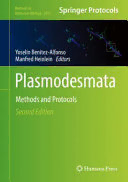
Plasmodesmata: Methods and Protocols PDF
Preview Plasmodesmata: Methods and Protocols
Methods in Molecular Biology 2457 Yoselin Benitez-Alfonso Manfred Heinlein Editors Plasmodesmata Methods and Protocols Second Edition M M B ETHODS IN OLECULAR IO LO GY SeriesEditor JohnM.Walker School of Lifeand MedicalSciences University ofHertfordshire Hatfield, Hertfordshire, UK Forfurther volumes: http://www.springer.com/series/7651 For over 35 years, biological scientists have come to rely on the research protocols and methodologiesinthecriticallyacclaimedMethodsinMolecularBiologyseries.Theserieswas thefirsttointroducethestep-by-stepprotocolsapproachthathasbecomethestandardinall biomedicalprotocolpublishing.Eachprotocolisprovidedinreadily-reproduciblestep-by- step fashion, opening with an introductory overview, a list of the materials and reagents neededtocompletetheexperiment,andfollowedbyadetailedprocedurethatissupported with a helpful notes section offering tips and tricks of the trade as well as troubleshooting advice. These hallmark features were introduced by series editor Dr. John Walker and constitutethekeyingredientineachandeveryvolumeoftheMethodsinMolecularBiology series. Tested and trusted, comprehensive and reliable, all protocols from the series are indexedinPubMed. Plasmodesmata Methods and Protocols Second Edition Edited by Yoselin Benitez-Alfonso Centre for Plant Sciences, School of Biology, University of Leeds, Leeds, UK Manfred Heinlein Institut de Biologie Moléculaire des Plantes, CNRS, Université de Strasbourg, Strasbourg, France Editors YoselinBenitez-Alfonso ManfredHeinlein CentreforPlantSciences,Schoolof InstitutdeBiologieMole´culairedesPlantes,CNRS Biology Universite´deStrasbourg UniversityofLeeds Strasbourg,France Leeds,UK ISSN1064-3745 ISSN1940-6029 (electronic) MethodsinMolecularBiology ISBN978-1-0716-2131-8 ISBN978-1-0716-2132-5 (eBook) https://doi.org/10.1007/978-1-0716-2132-5 ©TheEditor(s)(ifapplicable)andTheAuthor(s),underexclusivelicensetoSpringerScience+BusinessMedia,LLC,part ofSpringerNature2022 Thisworkissubjecttocopyright.AllrightsaresolelyandexclusivelylicensedbythePublisher,whetherthewholeorpart of the material is concerned, specifically the rights of translation, reprinting, reuse of illustrations, recitation, broadcasting,reproductionon microfilmsorinanyotherphysicalway,andtransmissionorinformation storageand retrieval,electronicadaptation, computersoftware,orbysimilar ordissimilar methodologynow knownorhereafter developed. Theuseofgeneraldescriptivenames,registerednames,trademarks,servicemarks,etc.inthispublicationdoesnotimply, evenintheabsenceofaspecificstatement,thatsuchnamesareexemptfromtherelevantprotectivelawsandregulations andthereforefreeforgeneraluse. Thepublisher,theauthorsandtheeditorsaresafetoassumethattheadviceandinformationinthisbookarebelievedto betrueandaccurateatthedateofpublication.Neitherthepublishernortheauthorsortheeditorsgiveawarranty, expressedorimplied,withrespecttothematerialcontainedhereinorforanyerrorsoromissionsthatmayhavebeen made.Thepublisherremainsneutralwithregardtojurisdictionalclaimsinpublishedmapsandinstitutionalaffiliations. CoverIllustrationCaption:3D-SIMimageofplasmolysedBY2cellsshowingERlabelledwithRTN6-GFP(green)and cellwalllabelledwithCalcofluorWhite(blue).ImageproducedbyKirstenKnox. ThisHumanaimprintispublishedbytheregisteredcompanySpringerScience+BusinessMedia,LLCpartofSpringer Nature. Theregisteredcompanyaddressis:1NewYorkPlaza,NewYork,NY10004,U.S.A. Preface Plasmodesmata, the nanochannels that connect plant cells, are crucial for intercellular signaling by playing a key role in plant development and response to the environment. Research on plasmodesmata structure and regulation is growing as accumulating evidence relatesthefunctionofthesechannelstocropyieldaswellasresiliencetoclimatechangeand devastating diseases. Despite their importance, we are still far from being able to translate knowledge on plasmodesmata structure and function into the design of strategies to improve food security. This is partly due to the lack of tools and resources to study these channels and to enable their targeted modification. Nevertheless, thefield hasmade major advancesinbothmethodologyandcurrentknowledge. Thus, following the first edition of Plasmodesmata: Methods and Protocols published in 2015,itbecametimetocreateasecondedition,whichcompilesnew,up-to-dateprotocols, writtenbyexpertsinthefieldofplasmodesmataresearch.Theaimistofacilitatethestudyof these structures and to instigate new research that will further advance our knowledge on plasmodesmata in labs around the world. Plasmodesmata research was classically driven by cell biologists, but in recent years we acknowledge the significant contribution of other disciplinesincludingbiochemistry,molecularbiology,andmathematicalmodeling.Conse- quently, protocols in the book expand to a broad range of disciplines suitable for studying plasmodesmatafrommultipleangles. The book is divided into five parts: the first part contains two reviews addressing the general structural composition and regulation of plasmodesmata as well as discussing their role in plant development and disease. The second part is dedicated to methods to study plasmodesmata architectures and distribution in cell interfaces, including the most recent advancesinpreparingandimagingtheplantmaterialusingelectrontomographyandhigh- resolution microscopy. The third part focuses on approaches to dissect plasmodesmata composition, specially targeting callose accumulation and membranes lipidomic and pro- teomic analysis as well as methods to study protein clustering and membrane organization around plasmodesmata. The fourth part collects protocols to quantify changes in plasmo- desmata permeability using fluorescent tracers and mobile proteins. This section also con- tainstoolstointerrogateplasmodesmatafunctionusingvectorsforcalloseinductionanda forward genetic screen to identify trafficking regulators. To conclude, we included a fifth partwithprotocolsthatcontributetoplasmodesmataresearchbutfalloutsidetheprevious classifications. These are tools to visualize mobile RNAs, to image cell interfaces in the meristem, and to measure/predict symplasmic connectivity using modeling and computa- tionalapproaches. We,theeditors,believethiscompendiumwillbeusefultoallplantscientists,especially those studying cell-to-cell communication pathways. We have worked with the authors to make the protocols accessible to beginners and experts; thus the book will be useful for advanced researchers as well as for the teaching and training of young scientists. We hope thatthisbookwillbecomeamajor resourceinthelaboratories. Leeds,UK YoselinBenitez-Alfonso Strasbourg,France Manfred Heinlein v Contents Preface ..................................................................... v Contributors................................................................. xi PART I OVERVIEWARTICLES 1 PlasmodesmataStructuralComponentsandTheirRoleinSignaling andPlantDevelopment.................................................. 3 PhilipKirkandYoselinBenitez-Alfonso 2 FunctionofPlasmodesmataintheInteractionofPlants withMicrobesandViruses............................................... 23 CaipingHuangandManfredHeinlein PART II STRUCTURE AND DISTRIBUTION OF PLASMODESMATA 3 PlasmodesmataUltrastructureDeterminationUsingElectron Tomography ........................................................... 57 JulesD.Petit,MarieGlavier,LysianeBrocard, andEmmanuelleM.F.Bayer 4 UltrastructuralAnalysisandThree-DimensionalReconstruction ofPlasmodesmata....................................................... 75 KamilaGodel-Je˛drychowska,TilmanFranke,andEwaKurczyn´ska 5 SerialBlockElectronMicroscopytoStudyPlasmodesmata intheVasculatureofArabidopsisthalianaRoots............................ 95 AndreaPaterliniandIlyaBelevich 6 FocusedIonBeam-ScanningElectronMicroscopyforInvestigating PlasmodesmalDensities.................................................. 109 BrandonC.Reagan,JohnR.Dunlap,andTessaM.Burch-Smith 7 MeasuringPlasmodesmataDensityonCellInterfacesofMonocot LeavesUsing3DImmunolocalizationandScanningElectron Microscopy............................................................. 125 FlorenceR.Danila 8 Super-ResolutionImagingofPlasmodesmataUsing3DStructured IlluminationMicroscopy................................................. 143 KirstenKnox PART III COMPOSITIONAL ANALYSIS OF PLASMODESMATA 9 InVivoAnilineBlueStainingandSemiautomatedQuantification ofCalloseDepositionatPlasmodesmata................................... 151 CaipingHuang,JeroˆmeMutterer,andManfred Heinlein 10 ImmunofluorescenceDetectionofCalloseinPlantTissueSections ........... 167 SamAmsburyandYoselinBenitez-Alfonso vii viii Contents 11 CalloseDetectionandQuantificationatPlasmodesmatainBryophytes........ 177 ArthurMuller,TomomichiFujita,andYoanCoudert 12 IsolationofPlasmodesmataMembranesforLipidomicandProteomic Analysis................................................................ 189 LaetitiaFouillen,Ste´phaneClaverol,EmmanuelleM.F.Bayer, andMagaliS.Grison 13 MethodsforDetectionofProteinInteractionswithPlasmodesmata- LocalizedReticulons .................................................... 209 VerenaKriechbaumerandStanleyW.Botchway 14 StudyingProtein–ProteinInteractionsatPlasmodesmatabyMeasuring Fo¨rsterResonanceEnergyTransfer ....................................... 219 PatrickBlu¨mke,VickyHowe,andRu¨digerSimon 15 QuantifyingtheOrganizationandDynamicsofthePlantPlasma MembraneAcrossScalesUsingLightMicroscopy .......................... 233 JosephF.McKenna 16 UsingSteady-StateFluorescenceAnisotropytoStudyProteinClustering...... 253 AjeetChaudharyandKaySchneitz PART IV FUNCTIONAL ANALYSIS OF PLASMODESMATA 17 QuantificationofCell-to-CellConnectivityUsingParticle Bombardment.......................................................... 263 EsteeE.Tee,SebastianSamwald,andChristineFaulkner 18 InvestigatingPlasmodesmataFunctioninArabidopsisThaliana UsingaLow-PressureBombardmentSystemandGFPMovementAssay ...... 273 JessicaC.FernandezandTessaM.Burch-Smith 19 QuantifyingPlasmodesmatalTransportwithanImprovedGFPMovement Assay.................................................................. 285 WilsonHornerandJacobO.Brunkard 20 AnArabidopsisCallusGraftingMethodtoTestCell-to-CellMobility ofProteins............................................................. 299 FrankMachin,Yag˘murHasbiog˘lu,andFriedrichKragler 21 QuantificationofPlasmodesmataPermeabilityinArabidopsisLeaves byTracingtheMovementofGFP ........................................ 313 MinDiaoandShanjinHuang 22 TrackingIntercellularMovementofFluorescentProteinsinBryophytes....... 321 TakumiTomoi,YoanCoudert,andTomomichiFujita 23 VirusGenome-BasedReporter forAnalyzingViralMovementProteins andPlasmodesmataPermeability.......................................... 333 EkaterinaA.Lazareva, AnastasiaK.Atabekova,AlexanderA.Lezzhov, SergeyY.Morozov,ManfredHeinlein,andAndreyG.Solovyev 24 AnalysisoftheDistributionofSymplasmicTracersDuringZygotic andSomaticEmbryogenesis.............................................. 351 JustynaWr(cid:1)obel-Marek,KamilaGodel-Je˛drychowska, andEwaKurczyn´ska Contents ix 25 QuantifyingIntercellularMovementandProteinStoichiometry forComputationalModeling............................................. 367 LisaVandenBroeck,MariahGobble,andRosangelaSozzani 26 SpatiotemporalSpecificBlockingofPlasmodesmatabyCallose Induction.............................................................. 383 DaweiYan 27 AForwardGeneticApproachtoIdentifyPlasmodesmalTrafficking RegulatorsBasedonTrichomeRescue .................................... 393 MunenoriKitagawaandDavidJackson PART V OTHER APPROACHES CONTRIBUTING TO PLASMODESMATA RESEARCH 28 InVivoVisualizationofMobilemRNAParticlesinPlantsUsingBglG........ 411 EduardoJ.Pen˜aandManfredHeinlein 29 Multi-AngleInVivoImagingoftheArabidopsisthalianaShoot ApicalMeristem(SAM).................................................. 427 MichaelFuchsandJanU.Lohmann 30 MoreInsightsfromUltrastructuralandFunctionalPlasmodesmata DataUsingPDinsight................................................... 443 EvaE.Deinum 31 MeasuringIntercellularInterfaceAreainPlantTissuesUsingQuantitative 3DImageAnalysis...................................................... 457 GwendolynV.Davis,RichardS.Smith,andGeorgeW.Bassel Index ...................................................................... 465 Contributors SAMAMSBURY • SchoolofBiosciences,TheUniversityofSheffield,Sheffield,UK ANASTASIA K.ATABEKOVA • DepartmentofVirology,BiologicalFaculty,MoscowState University,Moscow,Russia;A.N.BelozerskyInstituteofPhysico-ChemicalBiology,Moscow StateUniversity,Moscow,Russia GEORGEW.BASSEL • SchoolofLifeSciences,TheUniversityofWarwick,Coventry,UK EMMANUELLEM.F.BAYER • LaboratoiredeBioge`neseMembranaire,UMR5200,CNRS, Universite´deBordeaux,Villenaved’OrnonCedex,France ILYABELEVICH • HelsinkiInstituteofLifeScience/InstituteofBiotechnology,Universityof Helsinki,Helsinki,Finland YOSELINBENITEZ-ALFONSO • CentreforPlantScience,SchoolofBiology,UniversityofLeeds, Leeds,UK PATRICKBLU¨MKE • InstituteforDevelopmentalGenetics,HeinrichHeineUniversity, Du¨sseldorf,Germany STANLEYW.BOTCHWAY • CentralLaserFacility,ScienceandTechnologyFacilitiesCouncil (STFC),RutherfordAppletonLaboratory,ResearchComplexatHarwell,Didcot,UK LYSIANEBROCARD • BordeauxImagingCentre,PlantImagingPlatform,UMS3420, INRA-CNRS-INSERM-UniversityofBordeaux,Villenaved’Ornon,France JACOBO.BRUNKARD • LaboratoryofGenetics,UniversityofWisconsin-Madison,Madison, WI,USA;DepartmentofPlantandMicrobialBiology,UniversityofCaliforniaat Berkeley,Berkeley,CA,USA;PlantGeneExpressionCenter,U.S.Departmentof Agriculture,AgriculturalResearchService,Albany,CA,USA TESSAM.BURCH-SMITH • DepartmentofBiochemistry&CellularandMolecularBiology, UniversityofTennessee,Knoxville,TN,USA;DonaldDanforthPlantScienceCenter, SaintLouis,MO,USA AJEETCHAUDHARY • PlantDevelopmentalBiology,TUMSchoolofLifeSciences,Technical UniversityofMunich,Freising,Germany;DepartmentofPlantBiology,Carnegie InstitutionforScience,Stanford,CA,USA STE´PHANECLAVEROL • PlateformeProteome,Universite´deBordeaux,Bordeaux,France YOANCOUDERT • LaboratoireReproductionetDe´veloppementdesPlantes,ENSdeLyon, Lyon,France FLORENCER.DANILA • ResearchSchoolofBiology,TheAustralianNationalUniversity, Acton,ACT,Australia GWENDOLYNV.DAVIS • SchoolofLifeSciences,TheUniversityofWarwick,Coventry,UK EVAE.DEINUM • WageningenUniversity,Wageningen,TheNetherlands MINDIAO • iHumanInstitute,ShanghaiTechUniversity,Shanghai,China JOHNR.DUNLAP • TheJointInstituteforAdvancedMaterials,UniversityofTennessee, Knoxville,TN,USA CHRISTINEFAULKNER • CropGenetics,JohnInnesCentre,NorwichResearchPark,Norwich, UK JESSICAC.FERNANDEZ • DepartmentofBiochemistry&CellularandMolecularBiology, UniversityofTennessee,Knoxville,TN,USA;DepartmentofBotany,Universityof Wisconsin,Madison,WI,USA xi
